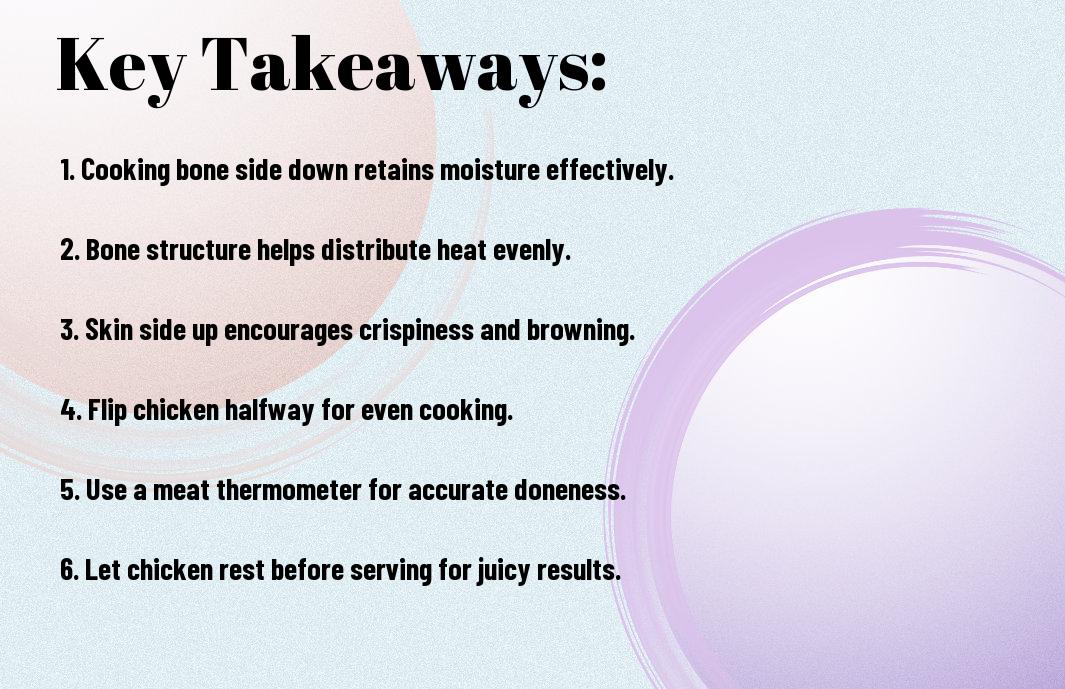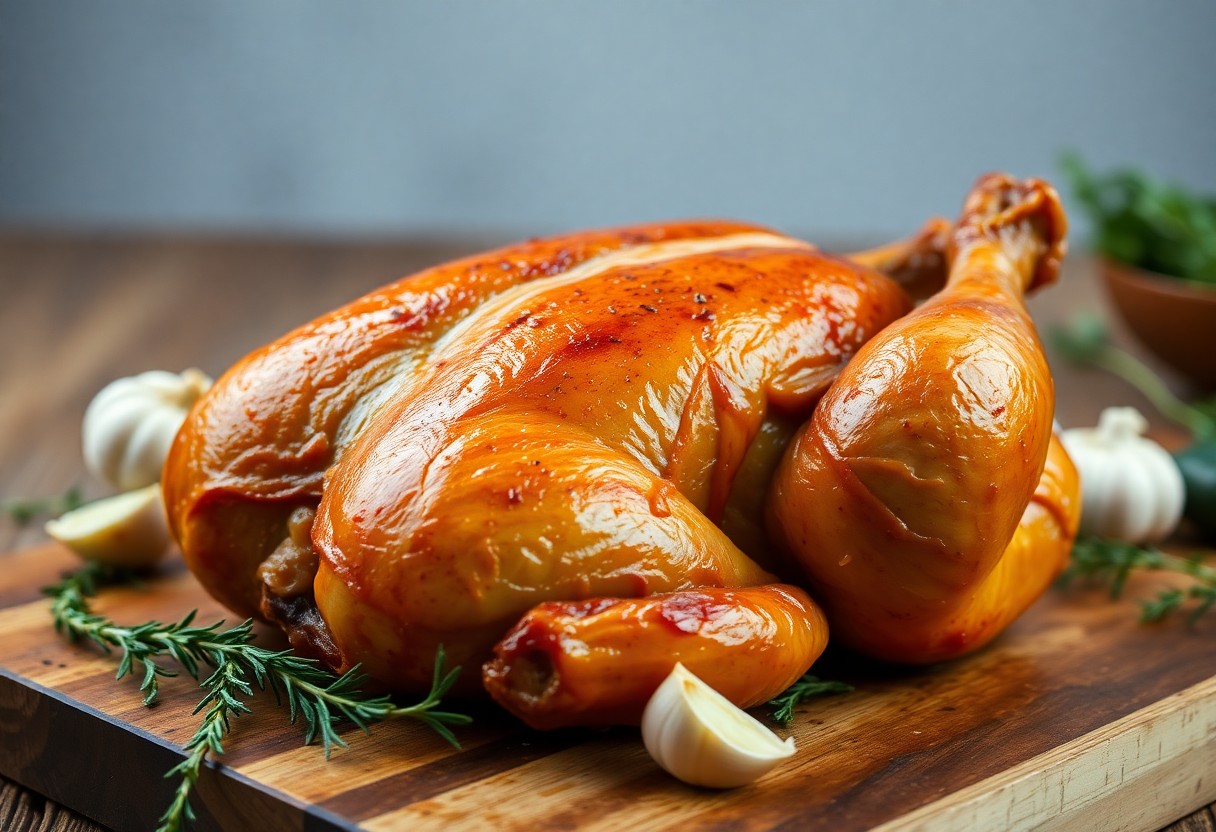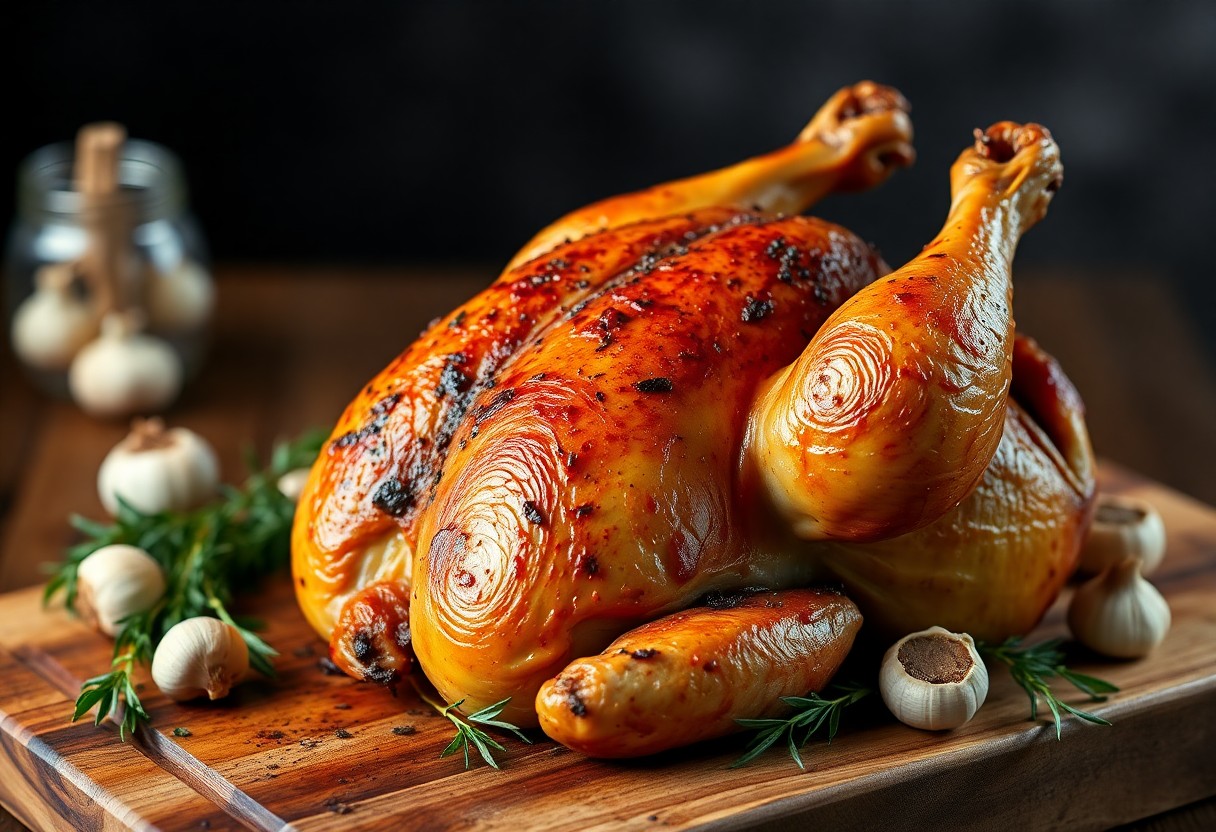Just as you want perfectly cooked chicken every time, understanding how to position your chicken during cooking is imperative. The debate on whether to cook chicken bone side up or down can affect the juiciness and tenderness of your meat. Choosing the right side not only enhances flavor but also ensures even cooking, reducing the risk of undercooked meat. In this post, you’ll learn the best practices for achieving mouthwatering chicken that keeps your guests coming back for more.
Key Takeaways:
- Placing chicken bone side down allows for even heat distribution and helps keep the meat moist during cooking.
- Cooking chicken with the skin side up can enhance crispiness and flavor, but may lead to drier meat if not monitored closely.
- Consider the cooking method and desired outcome; roasting versus grilling may affect the best position for achieving juicy results.


Understanding Chicken Anatomy
Your knowledge of chicken anatomy is important when it comes to cooking the perfect bird. Understanding the various parts, including the breast, thighs, and wings, helps you determine the best cooking methods to enhance flavor and tenderness. In particular, the bone structure plays a significant role in how heat distributes throughout the meat, affecting the overall cooking process and final results. This insight allows you to make informed decisions about how to place the chicken in the pan or oven to achieve the juiciest results.
The Importance of Bone Position
Below, we’ll explore how the position of the chicken’s bone can significantly impact the cooking process. When you cook a chicken with the bone side down, the meat benefits from the heat being absorbed through the bone, resulting in more evenly cooked and tender meat. Conversely, placing the bone side up may lead to uneven cooking and drier cuts. Understanding this simple principle can help you elevate your cooking game.
Meat Juiciness and Flavor
With the right cooking techniques, you can enhance the juiciness and flavor of the chicken. Placing the chicken with the bone side down allows the natural juices to flow into the meat, enriching its taste and tenderness. Additionally, the bone acts as a natural insulator, protecting the meat from direct heat and ensuring a succulent end product.
In addition, cooking with the bone side down keeps the meat moist by trapping the aromatic juices that would otherwise escape during the cooking process. This technique ensures that the chicken retains its own flavors while absorbing any seasonings or marinades applied. By using this method, you can consistently achieve juicy and flavorful chicken that will impress your family and friends. The proper positioning not only enhances texture but also contributes to a mouthwatering aroma, making your dish even more appetizing.
Cooking Techniques
You have several cooking methods to choose from when preparing delicious chicken. Each technique can yield different textures and flavors, so understanding them can elevate your culinary skills. Whether you prefer roasting or grilling, the method you select will influence how juicy and flavorful your chicken turns out.
Roasting Chicken
Any time you roast chicken, consider placing it bone side down. This technique helps the juices flow into the meat, keeping it moist and tender while creating a crispy, golden skin. Don’t forget to baste occasionally for added flavor!
Grilling Chicken
Beside roasting, grilling chicken offers a fantastic smoky flavor that many adore. You have the option to cook your chicken bone side up or down, but starting bone side down can help avoid flare-ups and ensure even cooking.
Hence, when grilling, be sure to take proper precautions. Always monitor the heat to prevent burning and make sure the chicken cooks through completely, ideally reaching an internal temperature of 165°F. Utilize a meat thermometer for accuracy and flip your chicken only once to achieve those perfect grill marks. This technique also allows the fat to render out, resulting in a juicier and more flavorful finished product. Enjoy that delicious grilled chicken!
Expert Opinions
Unlike common beliefs, expert opinions on whether to cook chicken bone side up or down can vary. Top chefs and culinary scientists emphasize that the cooking method can significantly impact the texture and juiciness of the meat. Understanding these expert insights can elevate your roasting skills, ensuring your chicken turns out succulent and flavorful.
Chefs’ Recommendations
With their extensive experience, chefs often recommend cooking chicken bone side down. This method allows the juices to flow into the meat, resulting in a richer flavor profile. Moreover, it helps to achieve a golden-brown crispy skin that enhances the overall presentation of your dish.
Culinary Science Insights
Among culinary scientists, the consensus leans toward the idea that cooking chicken bone side down promotes the best moisture retention. This position contributes to a more consistently juicy interior as the heat circulates around the meat. When the bones are on the bottom, they conduct heat effectively, ensuring the meat cooks evenly and prevents drying out.
Recommendations suggest that cooking chicken with the bone side down not only enhances moisture but also influences caramelization of the skin, which adds flavor. Be cautious of overcooking, as it can lead to drier meat despite bone placement. The interplay between heat and moisture is vital, so adjusting cooking time and temperature is vital for achieving perfectly roasted chicken, leaving you with delicious and juicy results.

Common Myths
Despite many beliefs circulating in culinary circles, the way you cook chicken can foster a myriad of misconceptions. One prevalent myth suggests that cooking chicken bone side up always yields juicier meat, while some argue the opposite. Understanding these myths is vital for improving your cooking techniques and achieving delicious results.
Dispelling Misconceptions
Behind these myths lies a mix of anecdotal evidence and tradition, leading to confusion about the best cooking practices. Many home cooks swear by different methods, yet the underlying principles are often overlooked. Separating fact from fiction will empower you to make the right choices in the kitchen.
The Truth About Cooking Positions
An crucial aspect of cooking chicken involves the position it is placed in during preparation. Many people believe that the bone side should face up for optimal flavor, but this isn’t always the case. Cooking chicken bone side down can actually enhance moisture retention within the meat, as the bones act as a barrier, keeping juices contained. Also, when cooking skin-on chicken, a crispy skin can be achieved by placing it skin side up initially, allowing the fat to render while keeping the meat tender beneath.
Common misconceptions around chicken cooking positions can greatly affect the outcome of your meal. It’s vital to understand that the bone helps insulate the meat from direct heat, allowing it to cook more evenly and stay juicy. Conversely, placing chicken bone side up can lead to uneven cooking, resulting in drier meat. By recognizing these factors, you can ensure a deliciously satisfying dish every time. Experimenting with different methods will enhance your culinary skills and confidence in the kitchen.
Best Practices for Cooking
Not all cooking methods yield the same results. To achieve the perfect chicken, consider the following best practices that enhance flavor and tenderness while ensuring your dish remains safe to consume.
Tips for Juicier Meat
The key to achieving juicy chicken lies in proper cooking techniques. Follow these tips to elevate your dish:
- Start with bone-in, skin-on chicken for added moisture
- Use a meat thermometer to avoid overcooking
- Let your chicken rest after cooking, sealing in the juices
After implementing these strategies, you’ll notice a marked difference in your chicken’s texture and flavor.
Seasoning and Marinade Essentials
Along with cooking techniques, seasoning can make or break your chicken dish. A good marinade not only enhances flavor but also tenderizes the meat.
Due to the beneficial effects of marinating, incorporating various herbs, spices, and acidic components like lemon juice or vinegar will significantly enhance the flavor profile of your chicken. Ensure you let your chicken soak in the marinade for at least 30 minutes, and consider longer periods for deeper flavors. Using fresh herbs can provide a vibrant taste, while ingredients like yogurt are excellent for tenderizing. Balance your ingredients for optimal taste, as well as to avoid overpowering the chicken’s natural flavor.
To wrap up
As a reminder, positioning your chicken with the bone side down during cooking is imperative for ensuring juicy, flavorful meat. This method allows the juices to flow through the meat while keeping the skin crisp. By following this simple technique, you can elevate your chicken dishes and impress your guests with perfectly cooked meals. Next time you cook chicken, keep the bone side down, and enjoy the delicious results.
FAQ
Q: Should I cook chicken bone side up or down for better results?
A: Cooking chicken bone side down is generally recommended. This position allows the bones to transfer heat more efficiently during the roasting process, leading to juicier meat. The fat and juices rendered during cooking will also help to baste the chicken, enhancing flavor and moisture.
Q: What are the benefits of cooking chicken bone side down?
A: Cooking bone side down helps protect the meat from direct heat, which can keep it moister. This method also allows for more even cooking, as the heat circulates better around the chicken. The bone acts like an insulator and can help maintain the meat’s juiciness, ensuring a tender result.
Q: Is there ever a reason to cook chicken bone side up?
A: While it is generally preferred to cook bone side down, cooking chicken bone side up can be beneficial if you want to achieve a crispier skin. This method allows the skin to crisp up directly under the heat source. If you choose this method, consider using a brine or marinade to keep the meat juicy.
Q: How does cooking time change depending on bone position?
A: The cooking time may not change significantly depending on whether the chicken is bone side up or down. However, the method you choose can affect the overall doneness and moisture of the chicken. It’s important to use a meat thermometer to ensure that the internal temperature reaches 165°F (75°C), regardless of bone position.
Q: What tips can I follow for the juiciest chicken regardless of bone position?
A: For the juiciest chicken, regardless of whether you cook it bone side up or down, try to avoid overcooking. Brining the chicken before cooking can enhance moisture retention. Additionally, let the chicken rest for a few minutes after cooking; this allows the juices to redistribute throughout the meat, resulting in a more tender and flavorful dish.
